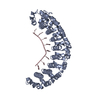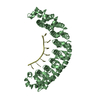[English] 日本語
 Yorodumi
Yorodumi- PDB-3q0n: Crystal structure of the PUMILIO-homology domain from Human PUMIL... -
+ Open data
Open data
- Basic information
Basic information
| Entry | Database: PDB / ID: 3q0n | ||||||
|---|---|---|---|---|---|---|---|
| Title | Crystal structure of the PUMILIO-homology domain from Human PUMILIO1 in complex with erk2 NRE | ||||||
 Components Components |
| ||||||
 Keywords Keywords | RNA binding protein/RNA / PUF / PUMILIO-homolgy domain /  Gene regulation / Gene regulation /  RNA binding / RNA binding protein-RNA complex RNA binding / RNA binding protein-RNA complex | ||||||
| Function / homology |  Function and homology information Function and homology informationregulation of miRNA-mediated gene silencing / positive regulation of miRNA-mediated gene silencing /  regulation of chromosome segregation / positive regulation of RIG-I signaling pathway / regulation of chromosome segregation / positive regulation of RIG-I signaling pathway /  post-transcriptional gene silencing / 3'-UTR-mediated mRNA destabilization / miRNA processing / miRNA binding / post-transcriptional regulation of gene expression / Golgi Associated Vesicle Biogenesis ...regulation of miRNA-mediated gene silencing / positive regulation of miRNA-mediated gene silencing / post-transcriptional gene silencing / 3'-UTR-mediated mRNA destabilization / miRNA processing / miRNA binding / post-transcriptional regulation of gene expression / Golgi Associated Vesicle Biogenesis ...regulation of miRNA-mediated gene silencing / positive regulation of miRNA-mediated gene silencing /  regulation of chromosome segregation / positive regulation of RIG-I signaling pathway / regulation of chromosome segregation / positive regulation of RIG-I signaling pathway /  post-transcriptional gene silencing / 3'-UTR-mediated mRNA destabilization / miRNA processing / miRNA binding / post-transcriptional regulation of gene expression / Golgi Associated Vesicle Biogenesis / mRNA destabilization / regulation of mRNA stability / adult locomotory behavior / mRNA 3'-UTR binding / post-transcriptional gene silencing / 3'-UTR-mediated mRNA destabilization / miRNA processing / miRNA binding / post-transcriptional regulation of gene expression / Golgi Associated Vesicle Biogenesis / mRNA destabilization / regulation of mRNA stability / adult locomotory behavior / mRNA 3'-UTR binding /  stem cell differentiation / stem cell differentiation /  P-body / cytoplasmic stress granule / P-body / cytoplasmic stress granule /  regulation of translation / regulation of translation /  spermatogenesis / spermatogenesis /  regulation of cell cycle / regulation of cell cycle /  axon / axon /  RNA binding / RNA binding /  nucleoplasm / nucleoplasm /  cytosol / cytosol /  cytoplasm cytoplasmSimilarity search - Function | ||||||
| Biological species |   Homo sapiens (human) Homo sapiens (human) | ||||||
| Method |  X-RAY DIFFRACTION / X-RAY DIFFRACTION /  MOLECULAR REPLACEMENT / Resolution: 2.4 Å MOLECULAR REPLACEMENT / Resolution: 2.4 Å | ||||||
 Authors Authors | Lu, G. / Hall, T.M.T. | ||||||
 Citation Citation |  Journal: Structure / Year: 2011 Journal: Structure / Year: 2011Title: Alternate modes of cognate RNA recognition by human PUMILIO proteins. Authors: Lu, G. / Hall, T.M. | ||||||
| History |
|
- Structure visualization
Structure visualization
| Structure viewer | Molecule:  Molmil Molmil Jmol/JSmol Jmol/JSmol |
|---|
- Downloads & links
Downloads & links
- Download
Download
| PDBx/mmCIF format |  3q0n.cif.gz 3q0n.cif.gz | 159 KB | Display |  PDBx/mmCIF format PDBx/mmCIF format |
|---|---|---|---|---|
| PDB format |  pdb3q0n.ent.gz pdb3q0n.ent.gz | 124.1 KB | Display |  PDB format PDB format |
| PDBx/mmJSON format |  3q0n.json.gz 3q0n.json.gz | Tree view |  PDBx/mmJSON format PDBx/mmJSON format | |
| Others |  Other downloads Other downloads |
-Validation report
| Arichive directory |  https://data.pdbj.org/pub/pdb/validation_reports/q0/3q0n https://data.pdbj.org/pub/pdb/validation_reports/q0/3q0n ftp://data.pdbj.org/pub/pdb/validation_reports/q0/3q0n ftp://data.pdbj.org/pub/pdb/validation_reports/q0/3q0n | HTTPS FTP |
|---|
-Related structure data
| Related structure data |  3q0lC  3q0mC  3q0oC  3q0pC  3q0qC  3q0rC  3q0sC C: citing same article ( |
|---|---|
| Similar structure data |
- Links
Links
- Assembly
Assembly
| Deposited unit | 
| ||||||||
|---|---|---|---|---|---|---|---|---|---|
| 1 | 
| ||||||||
| 2 | 
| ||||||||
| Unit cell |
|
- Components
Components
| #1: Protein | Mass: 40364.523 Da / Num. of mol.: 2 / Fragment: UNP residues 828-1176 Source method: isolated from a genetically manipulated source Source: (gene. exp.)   Homo sapiens (human) / Gene: PUM1, KIAA0099, PUMH1 / Plasmid: pTYB3 / Production host: Homo sapiens (human) / Gene: PUM1, KIAA0099, PUMH1 / Plasmid: pTYB3 / Production host:   Escherichia coli (E. coli) / Strain (production host): BL21(DE3) / References: UniProt: Q14671 Escherichia coli (E. coli) / Strain (production host): BL21(DE3) / References: UniProt: Q14671#2: RNA chain | Mass: 2487.521 Da / Num. of mol.: 2 / Source method: obtained synthetically / Details: This RNA sequence occurs naturally in humans. #3: Water | ChemComp-HOH / |  Water Water |
|---|
-Experimental details
-Experiment
| Experiment | Method:  X-RAY DIFFRACTION / Number of used crystals: 1 X-RAY DIFFRACTION / Number of used crystals: 1 |
|---|
- Sample preparation
Sample preparation
| Crystal | Density Matthews: 2.32 Å3/Da / Density % sol: 46.89 % |
|---|---|
Crystal grow | Temperature: 293 K / Method: vapor diffusion / pH: 5.5 Details: 15-20% (w/v) PEG 3350, 100 mM Li2SO4, and 100 mM Na3Citrate pH 5.5-6.0 , VAPOR DIFFUSION, temperature 293K |
-Data collection
| Diffraction | Mean temperature: 100 K |
|---|---|
| Diffraction source | Source:  ROTATING ANODE / Type: RIGAKU MICROMAX-007 HF / Wavelength: 1.5418 Å ROTATING ANODE / Type: RIGAKU MICROMAX-007 HF / Wavelength: 1.5418 Å |
| Detector | Type: RIGAKU SATURN 92 / Detector: CCD / Date: Jul 5, 2008 |
| Radiation | Monochromator: varimax hf / Protocol: SINGLE WAVELENGTH / Monochromatic (M) / Laue (L): M / Scattering type: x-ray |
| Radiation wavelength | Wavelength : 1.5418 Å / Relative weight: 1 : 1.5418 Å / Relative weight: 1 |
| Reflection | Resolution: 2.4→22.9 Å / Num. all: 31558 / Num. obs: 31306 / % possible obs: 99.2 % / Observed criterion σ(F): 2 / Observed criterion σ(I): 2 |
| Reflection shell | Resolution: 2.4→2.49 Å / % possible all: 94.2 |
- Processing
Processing
| Software |
| |||||||||||||||||||||||||||||||||||||||||||||||||||||||||||||||||||||||||||||
|---|---|---|---|---|---|---|---|---|---|---|---|---|---|---|---|---|---|---|---|---|---|---|---|---|---|---|---|---|---|---|---|---|---|---|---|---|---|---|---|---|---|---|---|---|---|---|---|---|---|---|---|---|---|---|---|---|---|---|---|---|---|---|---|---|---|---|---|---|---|---|---|---|---|---|---|---|---|---|
| Refinement | Method to determine structure : :  MOLECULAR REPLACEMENT / Resolution: 2.4→22.886 Å / SU ML: 1.07 / σ(F): 1.89 / Stereochemistry target values: Engh & Huber MOLECULAR REPLACEMENT / Resolution: 2.4→22.886 Å / SU ML: 1.07 / σ(F): 1.89 / Stereochemistry target values: Engh & Huber
| |||||||||||||||||||||||||||||||||||||||||||||||||||||||||||||||||||||||||||||
| Solvent computation | Shrinkage radii: 0.9 Å / VDW probe radii: 1.11 Å / Solvent model: FLAT BULK SOLVENT MODEL / Bsol: 55.86 Å2 / ksol: 0.354 e/Å3 | |||||||||||||||||||||||||||||||||||||||||||||||||||||||||||||||||||||||||||||
| Displacement parameters |
| |||||||||||||||||||||||||||||||||||||||||||||||||||||||||||||||||||||||||||||
| Refinement step | Cycle: LAST / Resolution: 2.4→22.886 Å
| |||||||||||||||||||||||||||||||||||||||||||||||||||||||||||||||||||||||||||||
| Refine LS restraints |
| |||||||||||||||||||||||||||||||||||||||||||||||||||||||||||||||||||||||||||||
| LS refinement shell |
|
 Movie
Movie Controller
Controller

















 PDBj
PDBj

